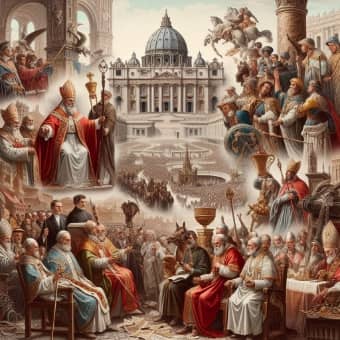The Historical Development of the Papacy
The Papacy, an enduring institution within the Christian world, is steeped in history and tradition, with origins tracing back nearly two millennia. As the central authority of the Roman Catholic Church, the Papacy has evolved through various historical epochs, adapting to political, social, and theological transformations.
This post explores the significant milestones in the historical development of the Papacy, highlighting its profound influence on global history.
This blog post contains affiliate links. When you click on a link on this page and make a purchase I may earn a small commission, at no additional cost to you. Thank you for your support.
Foundations of the Papacy
The Early Church
The roots of the Papacy can be traced to the early Christian community of Rome. According to tradition, St. Peter, one of Jesus Christ’s apostles, became the first Bishop of Rome. This connection established a foundational precedent for the subsequent primacy of the Roman See.
The early popes, such as St. Linus, St. Anacletus, and St. Clement I, were pivotal in consolidating the church’s structure and doctrines during a period of persecution and doctrinal disputes.

The Medieval Era
The Rise of Papal Power
The medieval period marked a significant chapter in the development of the Papacy, characterized by increased political and spiritual authority. Pope Gregory I (590-604), known as Gregory the Great, reinforced the papal role in administering the Western Church. His reforms of the liturgy and church organization laid the groundwork for the medieval Papacy.
The Investiture Controversy (1075-1122) was a major conflict between the Papacy and secular rulers over the appointment of bishops. Pope Gregory VII’s assertive stance against Emperor Henry IV marked a turning point, affirming the Papacy’s sovereignty over ecclesiastical appointments and solidifying its influence over temporal matters.
The Avignon Papacy and Western Schism
Not all periods of the Papacy were marked by stability. From 1309 to 1377, the Papacy was relocated to Avignon, France, due to political pressures. This period, known as the Avignon Papacy, saw increased French influence over the church.
It ended with Pope Gregory XI’s return to Rome, but soon after, the church faced the Western Schism (1378-1417), where multiple claimants to the papal throne existed simultaneously. The Council of Constance (1414-1418) resolved the schism, restoring a single pope and reaffirming the centrality of Rome.
Challenges and Changes
Renaissance and Reformation
The Renaissance brought about a cultural and intellectual revival, impacting the Papacy. Popes such as Julius II (1503-1513) and Leo X (1513-1521) were significant patrons of the arts, commissioning works by Michelangelo, Raphael, and other Renaissance masters.
However, this period also exposed the church to criticism for corruption and moral decay, prompting Martin Luther’s reformation efforts.
The Protestant Reformation (16th century) led to a profound schism within Western Christianity. In response, the Papacy initiated the Counter-Reformation, epitomized by the Council of Trent (1545-1563), which sought to address doctrinal issues and reforms. The council’s decrees affirmed papal authority and acted as a bulwark against Protestant expansion.
The Papacy in the Contemporary World
Modern Era
The modern era saw significant transformations within the Papacy amid changing global dynamics. The First Vatican Council (1869-1870) proclaimed the doctrine of papal infallibility, asserting the pope’s authority in matters of faith and morals.
The loss of the Papal States in 1870 relegated the pope to a spiritual leader, ultimately leading to the Lateran Treaty of 1929, which established Vatican City as an independent sovereign entity.
The 20th and 21st centuries have witnessed popes addressing global issues such as war, poverty, and human rights. Popes John XXIII and Paul VI ushered in the Second Vatican Council (1962-1965), promoting ecumenism and modernizing church practices.
Recent popes, including John Paul II, Benedict XVI, and Francis, have continued to shape the Papacy’s role in a rapidly evolving world, emphasizing dialogue, social justice, and pastoral care.
Conclusion
The historical development of the Papacy is a testament to its resilience and adaptability. From its apostolic origins to its contemporary significance, the Papacy has navigated and shaped the course of history.
Understanding this evolution provides insight into the enduring influence of the Papacy on both religious and secular spheres, highlighting its role as a cornerstone of Christian civilization.
Looking for unique Catholic gifts? Check out our gift guide!
Thank you for visiting my Moody Catholic blog. If you enjoyed reading this article please tell others by clicking on the share button in the lower right hand corner, right underneath the scroll to top arrow.
